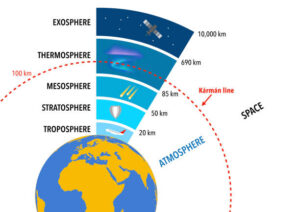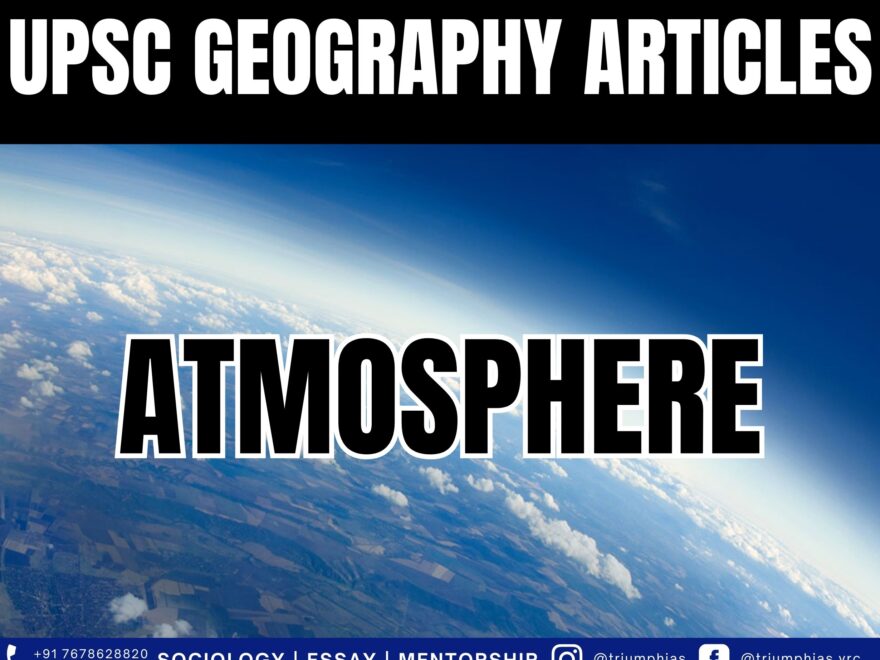Atmosphere
(Relevant for Geography Section of General Studies Paper Prelims/Mains)

One of the essential components of Earth’s interconnected physical systems is its atmosphere. The atmosphere consists of layers of gases enveloping the planet and other celestial bodies.
Earth’s atmospheric composition comprises approximately 78% nitrogen, 21% oxygen, and 1% other gases.
Nitrogen (N2): This gas constitutes the largest portion of the atmosphere. It stands as one of the primary essential nutrients crucial for the survival of all living organisms.
Oxygen (O2): Humans and animals draw oxygen from the air through respiration, while green plants generate oxygen during photosynthesis. This continuous cycle helps maintain a steady level of oxygen in the atmosphere.
Carbon dioxide (CO2): This gas plays a crucial role as a heat-trapping agent, often referred to as a greenhouse gas. It originates from the extraction and combustion of fossil fuels.
These gases are distributed across atmospheric layers defined by distinct characteristics such as temperature and pressure.
Composition
Troposphere
Earth’s troposphere stretches from the planet’s surface to an average altitude of around 12 kilometers, with varying heights across different regions—lower at the poles and higher at the equator.
Despite its relatively shallow depth, the troposphere fulfills vital roles. It contains the air necessary for photosynthesis in plants and breathing for animals. Moreover, approximately 99% of water vapor and aerosols, minute suspended solid or liquid particles, are found within this layer.
The temperature within the troposphere decreases as altitude increases. Above this layer lies the tropopause, a distinct boundary.
The troposphere stands as the densest layer, compressed by the weight of the atmosphere above it.
Stratosphere
Stretching from roughly 12 to 50 kilometers above Earth’s surface, the stratosphere is renowned for housing the ozone layer.
Within this region, temperature ascends as altitude increases. The formation of ozone generates heat, causing this rise in temperature.
While typically free of clouds and weather phenomena, polar stratospheric clouds (predominantly during winter) can appear at its coldest, lowest levels.
Between approximately 50 and 80 kilometers above Earth’s surface, the mesosphere experiences progressively colder conditions with rising altitude.
At its upper boundary lies the coldest point in the Earth system, featuring an average temperature of roughly minus 85 °C (-120 °F).
Limited water vapor in the upper mesosphere leads to the formation of noctilucent clouds, the highest clouds in Earth’s atmosphere.
Ionosphere
Positioned between about 80 and 700 kilometers above Earth’s surface, the ionosphere occupies its lower region.
Due to its proximity to the sun, this layer can reach temperatures of up to 2,000 °C (3,600 °F).
Temperatures here increase with altitude due to the sparse density of molecules. It is devoid of both clouds and water vapor.
The ionosphere doesn’t constitute a distinct layer like those mentioned earlier; rather, it overlaps the mesosphere, thermosphere, and exosphere.
Exsosphere
This is a dynamic part of the atmosphere that expands and contracts based on the solar energy it absorbs.
Spanning approximately 700 to 10,000 kilometers above Earth’s surface, the exosphere marks the highest layer of the planet’s atmosphere, merging with the solar wind at its upper boundary.
Molecules present here possess extremely low density, leading to behavior that doesn’t resemble that of a traditional gas; particles in this layer can escape into space.
Although the exosphere lacks weather phenomena, occurrences like the aurora borealis and aurora australis can occasionally be observed at its lower levels.
Significance
- Safeguarding Against Harmful Radiation: The atmosphere serves as a protective shield for life on Earth by deflecting incoming ultraviolet (UV) radiation, ensuring the planet’s warmth by providing insulation, and mitigating extreme temperature fluctuations between day and night.
- Weather and Climate Dynamics: The atmosphere’s pivotal role is in shaping weather and climate patterns, encompassing factors like temperature, precipitation, and wind. These patterns wield substantial influence over ecosystems, agriculture, and human endeavors.
- Control of Earth’s Temperature: Central to Earth’s temperature regulation, the atmosphere functions by capturing solar heat and preventing its dissipation into space. This mechanism, referred to as the greenhouse effect, sustains a temperature conducive to supporting life.
- Crucial Water Cycle Management: The atmosphere actively manages Earth’s water cycle by transporting water vapor from oceans to land, where it condenses into precipitation. This cycle plays a pivotal role in maintaining water resources across the planet.
To master these intricacies and fare well in the Sociology Optional Syllabus, aspiring sociologists might benefit from guidance by the Best Sociology Optional Teacher and participation in the Best Sociology Optional Coaching. These avenues provide comprehensive assistance, ensuring a solid understanding of sociology’s diverse methodologies and techniques.
Earth’s atmosphere, atmospheric composition, nitrogen, oxygen, carbon dioxide, atmospheric layers, troposphere, stratosphere, mesosphere, ionosphere, exosphere, ozone layer, greenhouse effect, ultraviolet radiation, temperature regulation, water cycle, weather and climate dynamics, aurora borealis, aurora australis, noctilucent clouds, Earth’s atmosphere, atmospheric composition, Earth’s atmosphere, atmospheric composition, Earth’s atmosphere, atmospheric composition, Best Sociology Optional Coaching, Sociology Optional Syllabus.

Choose The Best Sociology Optional Teacher for IAS Preparation?
At the beginning of the journey for Civil Services Examination preparation, many students face a pivotal decision – selecting their optional subject. Questions such as “which optional subject is the best?” and “which optional subject is the most scoring?” frequently come to mind. Choosing the right optional subject, like choosing the best sociology optional teacher, is a subjective yet vital step that requires a thoughtful decision based on facts. A misstep in this crucial decision can indeed prove disastrous.
Ever since the exam pattern was revamped in 2013, the UPSC has eliminated the need for a second optional subject. Now, candidates have to choose only one optional subject for the UPSC Mains, which has two papers of 250 marks each. One of the compelling choices for many has been the sociology optional. However, it’s strongly advised to decide on your optional subject for mains well ahead of time to get sufficient time to complete the syllabus. After all, most students score similarly in General Studies Papers; it’s the score in the optional subject & essay that contributes significantly to the final selection.
“A sound strategy does not rely solely on the popular
Opinion of toppers or famous YouTubers cum teachers.”
It requires understanding one’s ability, interest, and the relevance of the subject, not just for the exam but also for life in general. Hence, when selecting the best sociology teacher, one must consider the usefulness of sociology optional coaching in General Studies, Essay, and Personality Test.
The choice of the optional subject should be based on objective criteria, such as the nature, scope, and size of the syllabus, uniformity and stability in the question pattern, relevance of the syllabic content in daily life in society, and the availability of study material and guidance. For example, choosing the best sociology optional coaching can ensure access to top-quality study materials and experienced teachers. Always remember, the approach of the UPSC optional subject differs from your academic studies of subjects. Therefore, before settling for sociology optional, you need to analyze the syllabus, previous years’ pattern, subject requirements (be it ideal, visionary, numerical, conceptual theoretical), and your comfort level with the subject.
This decision marks a critical point in your UPSC – CSE journey, potentially determining your success in a career in IAS/Civil Services. Therefore, it’s crucial to choose wisely, whether it’s the optional subject or the best sociology optional teacher. Always base your decision on accurate facts, and never let your emotional biases guide your choices. After all, the search for the best sociology optional coaching is about finding the perfect fit for your unique academic needs and aspirations.
To master these intricacies and fare well in the Sociology Optional Syllabus, aspiring sociologists might benefit from guidance by the Best Sociology Optional Teacher and participation in the Best Sociology Optional Coaching. These avenues provide comprehensive assistance, ensuring a solid understanding of sociology’s diverse methodologies and techniques. Sociology, Social theory, Best Sociology Optional Teacher, Best Sociology Optional Coaching, Sociology Optional Syllabus.
Best Sociology Optional Teacher, Sociology Syllabus, Sociology Optional, Sociology Optional Coaching, Best Sociology Optional Coaching, Best Sociology Teacher, Sociology Course, Sociology Teacher, Sociology Foundation, Sociology Foundation Course, Sociology Optional UPSC, Sociology for IAS,
Follow us :


https://t.me/VikashRanjanSociology
Find More Blogs
|
Scope of the subject and comparison with other social sciences |
|||
|
|
|
|
Modernity and social changes in Europe |


One comment